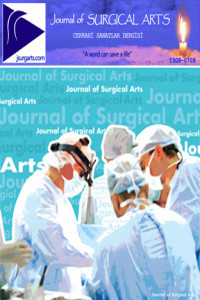FITIK TAMİRİNDE MESH KULLANIMI VE KOMPLİKASYONLARI
Her yıl milyonlarca insanda primer ventral, insizyonel ve inguinal fıtık meydana gelir. Toplumun %2-20’sinde fıtık vardır. İnsizyonel fıtıklar sıklıkla karın cerrahisinden sonra ve %54 lere varan sıklıkta görülebilir. Fıtık tamiri genel cerrahide en fazla yapılan ameliyatlardan birisidir. Son yirmi yılda fıtık tamirinde yeni teknik araçlar (prostetik mesh, laparoskopi) uygulamaya girdi. Prostetik meshlerin fıtık tamirinde kullanılması ile oluşan nüksler (<%20) primer dikiş teknikleriyle yapılan ameliyat sonrası nükslerine (~%50) göre önemli miktarda azaldı. Protez kullanılarak yapılacak gerginliği azaltıcı tamirlerin etkinliği konusunda bir fikir birliği oluştu. Buğün, inguinal fıtıkların %60’ında flat mesh, insizyonel fıtıkların %90’ında prosthetic mesh kullanıldığı sanılmaktadır. Tabii ve sentetik meshler bu anlamd ayılardır kullanılmaktadır. Bununla birlikte, mesh kullanımı enfeksiyon, seroma, fistül, barsak fistülü, yapışıklık, barsak tıkanmaları ve diğer nadir görülen komplikasyonlara yol açabilir. Bu komplikasyonlar farklı faktörlere bağlı (cerrah, teknik, kullanılan mesh özellikleri ve hastaya ait değişik özellikler…) olarak ortaya çıkar. Sonuç olarak, şimdiye kadar kullanılan materyaller ve tekniklerin hiçbirisi ideal mesh ve ideal teknik olarak tanımlanamamıştır. Henüz en iyi yaklaşım ve en iyi mesh hangisi sorusuna yeterli bir cevap verilememiştir. Bunun için, yeni prospektif, randomize klinik ve teknik çalışmalara ihtiyaç vardır.
Anahtar Kelimeler:
Fıtık, tamir, prostetik mesh ve komplikasyon
The use of mesh in hernia repair and It’s complications
Millions of patients are affected each year, presenting most commonly with primary ventral, incisional, and inguinal hernias. The incidence of hernia within the general population is estimated at 2% with 20% of cases occurring in adults. Incisional hernias occur frequently after abdominal surgery and recurrence after repair has been reported in up to 54% of patients. Hernia repair is one of the most common elective procedures in general surgery. The last two decades has brought new technical developments (prosthetic mesh, laparoscopy) to hernia repair. The use of prosthetic mesh to repair incisional and ventral hernias results in lower recurrence rates (<20%) compared with primary suture techniques (~50%). Agreement has been achieved that tension-free hernia repair using prostheses reduces recurrence rates significantly. Approximately 60% of prosthetic repairs of the inguinal floor are believed to use a flat mesh of some type, and 90% of incisional and ventral hernia repairs incorporate the use of a synthetic prosthesis. Prosthetic products, natural and synthetic, have been used in herniorrhaphy for decades. However, the use of prosthetic mesh for hernia repair can cause serious complications such as infection, seroma formation, fistulae formation, adhesion, biomaterial-related intestinal obstructions, and other miscellaneous complications. These complications are directly related to different factors (surgeon, technique, type of mesh used, patients with associated pathologies etc.). In conclusion, none of the available materials and techniques can be described as the "ideal mesh" and “ideal repair technique”, so far. Due to the quality of the available studies, the question concerning the best approach and the best mesh cannot be answered sufficiently yet. For these reason, we need prospective, randomised clinical and technical studies.
Keywords:
Hernia, repair, prosthetic mesh and complication,
- ISSN: 1308-0709
- Başlangıç: 2008
- Yayıncı: Osman Nuri DİLEK
Sayıdaki Diğer Makaleler
UZAMIŞ QT SENDROMLU BİR OLGU IŞIĞINDA PREOPERATİF EKG DEĞERLENDİRMESİNİN ÖNEMİ; Olgu sunumu.
Yüksel Ela, Remziye Gül Sıvacı, Tevfik Demir, Elif Bakı
Ayşe Güler, Aydın Köşüş, Nermin Köşüş, Hanım Güler Şahin
Ahmet Fikret Yücel, Ahmet Pergel, İbrahim Aydın, Erdem Hürsoy, Dursun Ali Şahin, Osman Nuri Dilek
İLEUS İLE PREZENTE OLAN MORGAGNİ HERNİSİ; Olgu sunumu
Hıdır Eşme, Dursun Ali Şahin, Okan Solak, Murat Sezer
FITIK TAMİRİNDE MESH KULLANIMI VE KOMPLİKASYONLARI
Osman Nuri Dilek, Kadir Serkan Türel
ENTÜBASYON SIRASINDA REFLEKS BRADİKARDİ
Yüksel Ela, Hüseyin Fidan, Remziye Gül Sıvacı, Tevfik Demir, Elif Bakı
